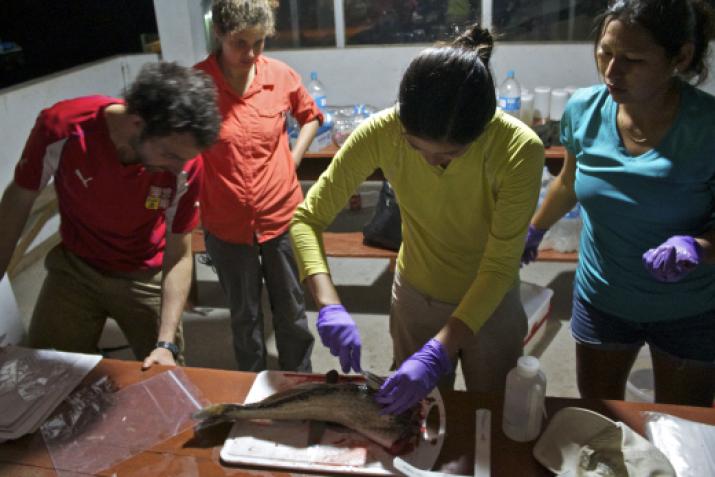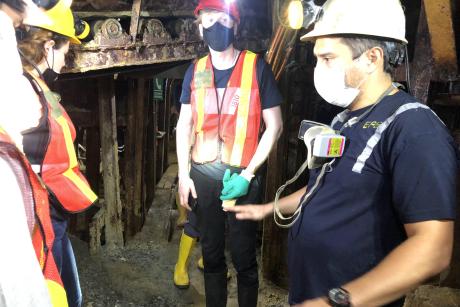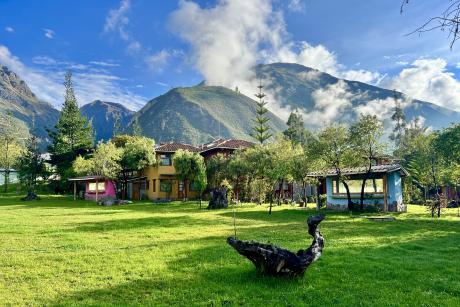By Charlotte Lee
Peru Bass Connections Research Project
Over a month in the field, traveling the 407 miles of the Madre de Dios River, we have become masters of movement. These have been long days, often 14-18 hours of work, stopping only to eat or to get on the boat to the next site. Hours on the boat traveling between communities and sampling sites are invaluable for naps, fresh breezes that are almost as good as central air, sanity, peace, and reflection. The river is a therapy like no other. It’s beautiful but dangerous. Beneath the murky surface are caimans, boas, piranhas, sting rays, and fish with spines and teeth that are totally river monster worthy. Plus when taking sediment samples, there have been times when we sink past our knees in the mud. There is so much mud. Still I’ve been swimming a handful of times and the water is the most refreshingly perfect temperature.
There is no doubt that this is the Amazon. We stop to look at toucans on the way to breakfast. We subject our swollen feet to rubber boots to protect us from the plethora of poisonous snakes that live in MDD. We take antihistamines so we don’t tear our mosquito, chigger, sandfly, no-see-um, ant, flea bitten skin to pieces from the unbearable itchiness. We spend every day covered in a layer of sweat, eagerly awaiting the bit of coolness that comes with the stars at night. Ooh the stars here, wish I could describe it. My mom would say they’re “thick as spilt sugar.” You can see the Milky Way almost every night, and every time you look up it’s just as breathtaking. At first it was strange, seeing all these southern hemisphere stars in unrecognizable patterns. Now I can pick out the Southern Cross, but I’m still in complete awe of the enormity of the sky.
Every day is Spanglish. Sometimes every other sentence is in English or Spanish. My español is improving rapidly, but the hardest part is being tired. I’m not at a point where I can check out or space out and still get what’s going on, the way I can in English. Long conversations can be utterly exhausting. Everything in Peru is -ito and -ita: heladito, pescadito, ahorita. You can just say “buenos” as a greeting instead of doing the whole “buenos dias” deal. And if you’re fun like our field director Ernesto you can say chaufa for goodbye instead of ciao. Chaufa is the word for fried rice that Peruvians make at the many chifas (Chinese restaurants) in cities like Lima. Since it starts with the ciao sound, you just add a “fa” and suddenly you’re so fun! There are other cool Peruvian phrases derived from food that I thought were so interesting–
- Soy zanahoria (literally “I am a carrot”) means I’m healthy and have a good diet, exercise, etc.
- Estoy asado (literally “I’m roasted meat”) means I’m angry
- ¡Que lomo! (literally something like “how beefy”) means what a hot girl! referring to a woman as a piece of meat is kind of concerning, still interesting
We’ve been to 15 of our 17 sampling sites at this point (SO CLOSE OH MY GOSH), 13 of which were communities and 2 of the Amazon Conservation Association’s biological research stations. We are all eager to wrap up the sampling and celebrate by playing pool and getting pisco sours. It’s been a long hard road, but an incredible experience which has taught me so much. We didn’t end up getting the IRB approval for our human health sampling in time, so we’ve been doing entomological collections instead, along with the environmental sampling of sediment, water, and fish from the river. SO many bugs, so much mud, so much water filtration. SO much. Also, so much white rice consumption. Now that we’re almost done, it’s apparent what a large undertaking this project has been. It’s really quite ambitious to collect this much data, and we’ve all kind of decided that a month of fieldwork seems to be a bit of a maximum time length for retaining sanity. When I think about all that needs to get done at each site, it’s overwhelming.
(In case you’re interested, this is what we do at each site, if you’re not interested this will be REALLY boring—Environmental sampling: water collection, water filtration, water quality measurements, photos NSEW, sediment samples, fish muscle and liver samples, fishing or tracking down fishermen to acquire those fish, measuring velocity at three points across the river, depth measurement, GPS points & Entomological sampling: setting 3 CDC light traps, characterizing the vegetation at each site, soil description, photos NSEW, taking temperature and pressure, GPS points, looking for larvae at the three nearest households and three nearest water bodies, explaining that mosquitos lay their eggs in stagnant water to household owners, 4 hours in the Shannon trap manually aspirating mosquitos and sandflies, sorting and storing and labeling all the bugs caught & Dental hygiene charlas: giving lectures on brushing your teeth to elementary school children and giving out toothbrush and toothpaste)
But magically, when everyone takes a job, it all gets done. The power of teamwork is the only thing that has made this all possible. My personal favorite jobs are dissecting fish and giving the dental hygiene “charlas.” The Shannon trap is kind of fun when you don’t have to do it for the full four hours. There is some kind of sweet revenge in being able to suck up thousands of mosquitos. The project goals are to look at them for species diversity, vector presence, and test for malaria and leishmaniasis. My personal goals are to collect and, subsequently, kill as many as possible.
Other than my new taste for bug murder and delight in learning about fish anatomy, giving the charlas has been a real highlight. Axel, Ernesto, and I have been the charla team due mainly to our Spanish skills rather than any kind of dental hygiene charla giving prowess. I get to interact with kids who understand my weirdness, use my Spanish, and give the community some kind of immediate benefit. Before we left I thought it was kind of strange that we’d be doing these charlas and giving away toothbrushes and toothpaste. It didn’t seem to have a lot to do with our research and I thought maybe giving medicine or something else would be more important. However, it quickly became apparent how much of an issue dental hygiene is in these communities. Though there may not be fresh fruits and vegetables, there is never a deficit of soda, candy, cookies, and beer in any of these communities. The mouths of the adults are often filled with metal from dental work, or teeth are missing. Visible cavities in the mouths of the children are also common. The infections and pain that must accompany all of the dental issues must be treated at cities, because these communities don’t have dentists. Sometimes, maybe once a year, a dentist will come through for a day, but otherwise there is only self medication or expensive traveling to see a dentist in the city. I have a personal connection to all of these issues, because my own genetically useless enamel deteriorates all the time despite vigilant brushing, flossing, and soda & candy avoidance. For example, I think I’ve had 10 cavities filled in the past year. I can’t imagine my life without a dentist. So I really try to pound home the 3 times a day, 2 minutes each time, brush your tongue, don’t forget your molars spiel. The kids always laugh at me, and we have a grand old time having a “who can spit the farthest” contest after we all brush our teeth together.
At this point, we’ve had our last charla. We have just two communities left, and then we’re DONE. Hard to believe. We’re finishing earlier than it was originally planned, so we’ll be heading back to the states early. I’ll be back home on the 30th, and summer on the shore is going to taste so good.



